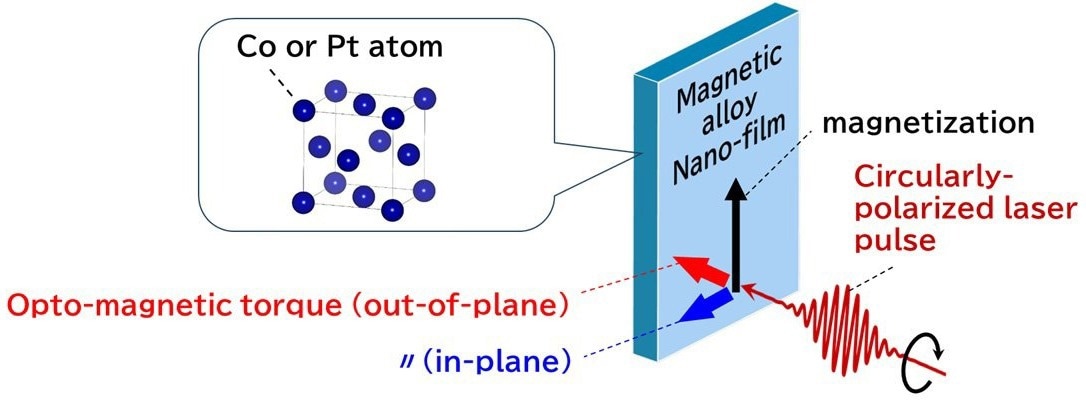Reviewed by Lexie CornerFeb 6 2025
Researchers at Tohoku University have made a significant breakthrough in opto-magnetic technology. They have demonstrated an opto-magnetic torque that is approximately five times more efficient than that of conventional magnets. The study was published in Physical Review Letters.
 When circularly polarized light is incident perpendicular to the surface of a nano-thin film of cobalt-platinum alloy, which consists of cobalt and platinum, an opto-magnetic torque is generated (red and blue vectors) that changes the magnetization direction (black vector). The opto-magnetic torque consists of components out-of-plane (red vector) and in-plane (blue vector). Image Credit: Nukui et al.
When circularly polarized light is incident perpendicular to the surface of a nano-thin film of cobalt-platinum alloy, which consists of cobalt and platinum, an opto-magnetic torque is generated (red and blue vectors) that changes the magnetization direction (black vector). The opto-magnetic torque consists of components out-of-plane (red vector) and in-plane (blue vector). Image Credit: Nukui et al.
The study, led by Professor Shigemi Mizukami, Assistant Professor Satoshi Iihama, and Mr. Koki Nukui, has important implications for the development of light-based spin memory and storage technologies.
Opto-magnetic torque is a method used to generate force on magnets, allowing for more efficient reorientation using light. The research team developed alloy nanofilms containing up to 70 % platinum dissolved in cobalt, demonstrating that platinum's relativistic quantum mechanical effects significantly enhance magnetic torque. The study attributes this increase to relativistic quantum mechanical interactions and electron orbital angular momentum induced by circularly polarized light.
This advancement enables the same opto-magnetic effect to be achieved with only one-fifth of the previously required light intensity, contributing to the development of more energy-efficient opto-magnetic devices. The findings not only support the design of high-efficiency spin memory and storage systems that use light for data writing but also provide new insights into the role of electron orbital angular momentum in metallic magnetic materials.
These improvements could result in faster and more energy-efficient devices in the future.
Shigemi Mizukami, Professor, Tohoku University
The study aligns with the growing interest in opto-electronic fusion technologies, which integrate optical and electronic methods for future applications. It marks a significant step in using light and magnetism to control nanomagnetic materials.
Journal Reference:
Nukui, K., et al. (2025) Light-Induced Torque in Ferromagnetic Metals via Orbital Angular Momentum Generated by Photon Helicity. Physical Review Letters. doi.org/10.1103/PhysRevLett.134.016701